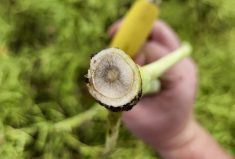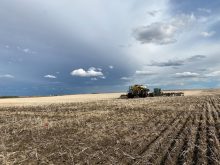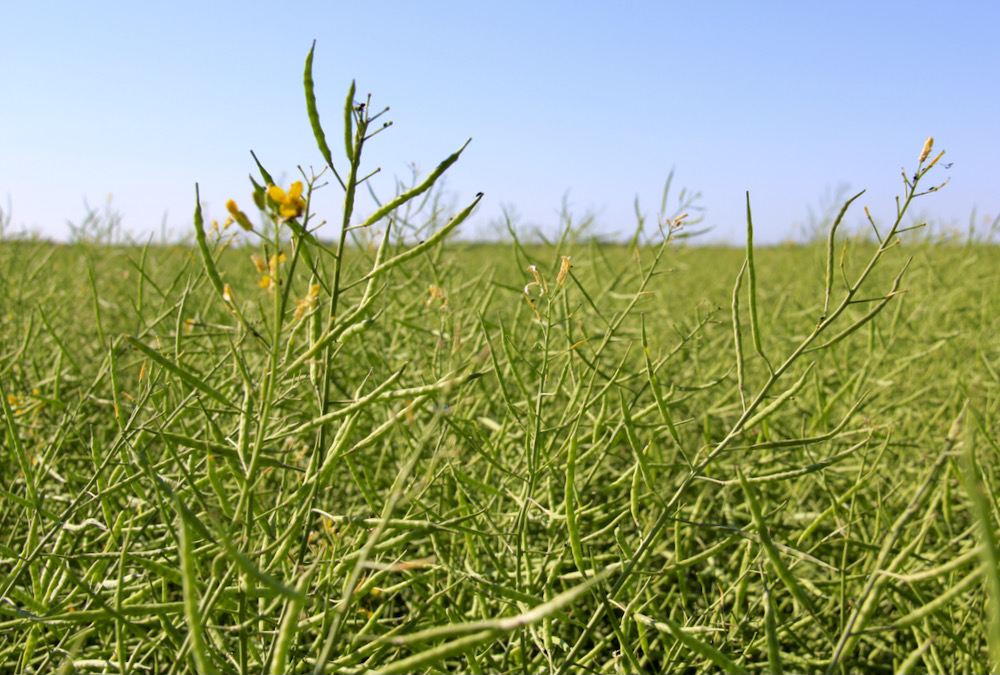Straight cutting is no longer merely an option for harvesting canola — it’s become “the” harvest option. In many cases, the one-pass alternative has replaced swathing completely.
“The decision to straight cut canola has been increasingly made for farmers in the past eight years,” says Dane Froese, oilseed specialist with Manitoba Agriculture.
“The advent of pod shatter-tolerant genetics has made straight cutting canola much more attractive than it is to swath. By and large, farmers are defaulting to straight cutting. In fact, it’s likely over 70 per cent of producers in Manitoba do it already and that number is expected to rise.”
Read Also

Cancer agency reclassifies another herbicide ‘probably carcinogenic’
The WHO’s cancer research agency has now put atrazine, a herbicide well known to corn growers, in the same potential-hazard category where the agency put glyphosate.
However, there’s no reason to park your swather in the back 40 yet — especially if you grow canola. For one thing, swathing expands harvest timing options; some farmers use a combination of swathing and straight cutting on a uniformly mature crop if they’d like to space out harvesting operations between fields.
Perhaps more crucially, swaths have a natural capability for drying down and maturing a crop without the use of costly desiccants and pre-harvest aids. Straight cutting tends to work best when the crop, canopy and stand are already well knit and uniform. However, when crops grow short of expectations, swathing can be a great tool for recharging the marketability of a low- to middle-tier canola crop.
Research has also shown canola will retain its quality in the swath better than other crops will.
“When you (swath) something like a cereal and you get rains on it, the quality usually drops fairly quickly, where canola can sit in a swath and get a massive amount of rain and will take more moisture than most other crops,” says Shawn Senko, a Saskatchewan-based agronomist with the Canola Council of Canada.
No shatter tolerance? Sorry, you have to swath
The most obvious reason for swathing is if you didn’t plant a pod shatter-tolerant canola variety in the spring. It’s fair to say most producers know what they’re planting, but if you aren’t aware of your variety’s shatter tolerance (this means resistance but is described as “tolerance” in the case of pod shatter), it may be worth a call to your seed retailer.
“If it’s a variety that shatters really easily, you almost have to swath at that point,” says Senko.
Adds Froese, “I wouldn’t recommend straight cutting those varieties at all. A lot of field hybrids and other hybrids don’t have that improved pod shatter tolerance.
“In that case, going out and swathing at that recommended 60 per cent colour change is the best practice. Lay that down into a fairly thick swath, cut stubble as high as possible to get all the seed and then run a roller over the swath, pushing the swath into the stubble so it gets knitted down and is somewhat protected from heavy winds.
“It’s usually about 10 days later that we see the crop change and move from 60 per cent seed colour change and become drier than the 10 per cent needed for harvest.”
Thin canopies benefit from straight cutting
You’ll want to check the quality of your canopy before making the decision to straight cut or swath. A canopy should be “well knit,” meaning the plants don’t sway and move independently in the wind. If they do, they’re at greater risk of pod shatter.
In cases like these, straight cutting is probably the better option, says Froese.
“Crops that are a little thinner are more susceptible to being blown about when they are placed into a swath,” says Froese.
“In the last few years, it almost seems like a guarantee that as soon as canola is swathed, we are going to get an 80- or 90-mile-per-hour wind that tends to blow swaths all over the field. Increasingly, farmers have tried to avoid swathing wherever possible and instead relying on pod shatter, high-reduction genetics to keep the crop in harvestable condition above ground and in the pods rather than going to the traditional swathing method.”
Part of keeping that crop in harvestable condition may include the use of a desiccant or other pre-harvest aid for drying down standing canola. However, these products have limits on when they can be used and still retain the crop’s marketability.
Swathing an option for variable crops and stands
As a general rule, swathing is a better choice when a crop is highly uneven or variable, says Froese. Uneven and variably mature crops can benefit from swathing because the swath hastens maturity and generally makes the crop a little more even in terms of dry down.
“We do tend to see that when we have really patchy emergence or really stagey crops like we do in flooded conditions.”
The canola industry strives for a plant stand of five to seven plants per square foot. If it’s lower than that — or higher in some areas and lower in others — that may be a sign you should look into swathing, says Froese. One reason is the individual plants in low population areas may be more likely to feature in-plant variability.
“If you’re in that three- to four-plants-per-square-foot area, swathing may be an advantage. Because of the non-uniformity of the canola crop, we might see a main stem that is completely ripe while the side branches could still be potentially throwing out flowers along the side.
“If a farmer isn’t willing or doesn’t have a contract that allows for the application of a pre-harvest aid or desiccant, then swathing as a mechanical means of terminating that crop is the best option.”
Then there’s the simple fact that higher density plants knit together better and run through a combine header much more uniformly and easily than low density stands. Leaving swaths of these subpar stands — not to mention haphazard, stagey and otherwise haggard crops — can help better prepare them for combining.
“Swathing can help even out some of those physical disparities in the field, making the canola swath a little more uniform and able to feed into the combine a lot better as well as allowing time for the crop to dry down when it might not have enough time when you’re running into a late season,” says Froese.
Fewer concerns of locking in green seed
Another scenario in which swathing might be the better choice is late-seeded or reseeded crops. This is a case where swathing’s natural desiccation can come in handy.
“If the farmer went in there and reseeded some of the sloughs and low-lying patches several weeks after the remainder of the crop, (swathing) would certainly be an option and might be well suited if they wanted to hasten the ripening process in those spots, not to mention trying to achieve full yield potential without having to break out the sprayer and spray every little patch, which could make it more non-uniform,” says Froese.
There are also less concerns over locking in green seed when swathing compared with using desiccants and pre-harvest aids before straight cutting, he says.
“The natural dry-down process with swathing is a little bit more forgiving in terms of allowing chlorophyll to dissipate from the green seed instead of freezing it in time and locking it in like a desiccant might if sprayed at the incorrect time.”
















